Ineffective MRO processes carry significant risks, which include among others, Unplanned equipment downtime.
Everything you need to know about Project Management
Table of Contents
As defined by PMBOK Project Management is the application of knowledge, skills, tools and techniques for project activities to meet project requirements. It involves planning, organizing, monitoring and controlling the project activities to accomplish the project requirements.
Project Management is now mainstream and used in everyday life.
Project Management methodologies have changed over time and will potentially continue to evolve as industries and technologies change.
Waterfall
The traditional form of project management adopted around the 1970’s. The Waterfall method is sequential and is extremely dependant on a definitive and clear outcome that the project is to deliver. It also very easy to recognise, as waterfall makes use of Gantt charts to map sequential work packages.
A typical approach is to start with documenting scoping requirements, analyse the best alternatives, design, construction, commission and maintain.
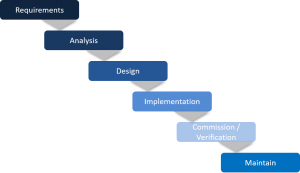
The Waterfall methodology is front end heavy in that a lot of the time and effort is spent within the initial planning of the scope and user requirements trying to define what the completed project looks like. This essentially is done to mitigate against risk of problems occurring within project execution. Scope Management and Resource Management throughout the project life cycle is somewhat easier and less reliant on management skills to be successful, where the lack of flexibility comes in however is within the change management area.
This methodology is easy to understand, and measure project performance, but it lacks flexibility.
Agile
Predominately used for IT and Software development, essentially whilst Waterfall is very structured and inflexible, Agile project management is relatively unstructured and fluid. Projects can start without a clear definition of what they are supposed to deliver and continue using an iterative process incorporating changes into the project as time goes on. Lean methodologies are quite popular, and this is where you will see the use of a kanban board to plan and schedule. There are a suite of tools and resources for agile project management that enables ‘on-the-fly’ change management, time tracking, team management and quality management.
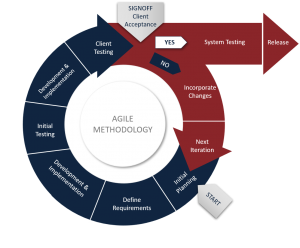
Well suited to creative projects, Agile methodologies allow the team to make changes along the way. Successful project managers will use the feedback loop as one of the key components within the life cycle to address early risk management and gaining project sponsor approval as part of their change management process.
This approach however does not have a fixed project schedule or project management plan and therefore can be very difficult to assign and manage human resources. Project management and leadership skills are required as resources will typically be turned on and off in an ad hoc manner, so gaining commitment for tasks becomes difficult.
Hybrid
As the name suggests and gaining more and more popularity is the Hybrid approach to project management, combining the Waterfall and Agile methodologies together. It attempts to maintain structure whilst remaining flexible.
Well suited to product development and product management, hybrid projects will normally spend some time gathering user requirements and scoping, then adopting the timebox and sprint approach for delivery of milestones.
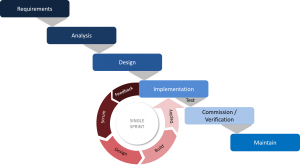
Scrum
Not formally a Project Management methodology but is being increasing adopted to tackle complex problems.
Scrum management process is a framework within which people can address complex adaptive problems, while productively and creatively delivering products of the highest possible value.
Scrum is an approach to Agile management with a focus on project teams, daily stand-up meetings, and short 30 day sprints. The short sprints are there to motivate rapid iteration, development and accountability.
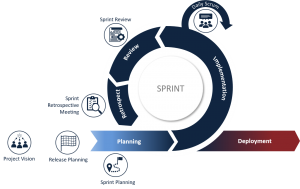
Normally the project team is expected to manage itself rather than a specific individual managing the project team. The organisation needs to be familiar and performing well in its maturity models for this methodology to work.
Some key risks with the scrum approach include scope creep as there is no fixed date, or project manager reporting on schedule and budget. For Scrum to work effectively you need a highly disciplined project team that is motivated.
Highly resource dependant, if a key resource leaves or becomes unavailable between sprints the impact is much larger than traditional forms of project management.
Critical Path Method (CPM)
CPM essentially uses a Work Breakdown Structure (WBS) by categorising activities and then mapping these out in a schedule with task duration, dependencies and tasks that can be completed simultaneously. This allows better resourcing and understanding of over resource allocation and budgetary spend. The series of activities that have the longest duration is the critical path, focus on having these activities completed on schedule are a priority.
The activities are front end heavy and require a fair bit of planning by the project team.
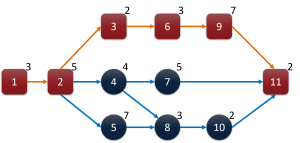
Critical Chain Project Management (CCPM)
CCPM is like CPM but has 2 iterations of the schedule. The schedule in the first iteration is normally developed in reverse by starting with the end date and working backwards, essentially planning the project activities to finish as late as possible. This process defines the latest start date of the project and has the least amount of room for error. A second review will then plan the project activities as early as possible, injecting the maximum amount of float across all workstreams. The path with the least amount of float is the critical path.
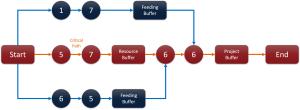
This practice then focuses on resourcing and ensuring the critical path has the best chance of being completed within the schedule timeframes.
PRINCE2
Wikipedia states PRINCE was derived from an earlier method called PROMPT II (Project Resource Organisation Management Planning Techniques). In 1989 the Central Computer and Telecommunications Agency (CCTA) adopted a version of PROMPT II as a UK Government standard for information systems (IT) project management. They gave it the name ‘PRINCE’, which originally stood for “PROMPT II IN the CCTA Environment”. PRINCE was renamed in a Civil service competition as an acronym for “Projects IN Controlled Environments”. PRINCE2 is the second edition of the earlier PRINCE method which was initially announced and developed in 1989 by CCTA (the central computer and Telecommunications Agency), a UK government support agency. PRINCE2 was released in 1996 as a generic project management method. PRINCE2 has become increasingly popular and is now a de facto standard for project management in many UK government departments and across the United Nations system.
The 7 Principles within PRINCE2 |
|
|
1 – Continued Business Justification |
The business case is the most important document and is updated at every stage of the project to ensure that the project is still viable. Early termination can occur if this ceases to be the case. |
|
2 – Learn from Experience |
Each project maintains a lessons log, and projects should continually refer to their own and to previous and concurrent projects’ lesson logs to avoid reinventing wheels. Unless lessons provoke change, they are only lessons identified (not learned). |
|
3 – Defined Roles and Responsibilities |
Roles are separated from individuals, who may take on multiple roles or share a role. Roles in PRINCE2 are structured in four levels (corporate or program management, project board, project manager level and team level). Project Management Team contains the last three, where all primary stakeholders (business, user, supplier) need to be presented. |
|
4 – Manage by Stages |
The project is planned and controlled on a stage-by-stage basis. Moving between stages includes updating the business case, risks, overall plan, and detailed next-stage plan in the light of new evidence. |
|
5 – Manage by Exception |
A PRINCE2 project has defined tolerances (6 aspects above) for each project objective, to establish limits of delegated authority. If a management level forecasts that these tolerances are exceeded (e.g. time of a management stage will be longer than the estimated time in the current management stage). it is escalated to the next management level for a decision how to proceed. |
|
6 – Focus on Products |
A PRINCE2 project focuses on the definition and delivery of the products, in particular their quality requirements. |
|
7 – Tailor to Suit Project Environment |
PRINCE2 is tailored to suit the project environment, size, complexity, importance, time capability and risk. Tailoring is the first activity in the process Initiating A Project and reviewed for each stage. |
Prince2 projects are heavy in administration and documentation, the idea behind this is that if projects are well documented, then learning from experience becomes easier and therefore reduces risk. Normally adopted for large high risk and complex projects.
Projects normally run-in phases or stages. Projects can have 3-5 phases depending on the industry, business, methodology and application. These are typically known as:
Phase 1 – Initiation |
|
|
The first project phase is where an idea, starts as a project. The aim of the initiation phase is to define the project. Within this phase the focus is to ensure the project business case is validated, the project scope is defined so that you know what it will and will not include, you identify any key constraints and risks, get all stakeholders on the same page, set out a project framework which will include a project charter and reporting framework, and finally identify which project methodology will be used to manage the project. At the end of the initiation phase, you should have a pretty good definition of what the project is setting out to achieve, its deliverables, requirements by stakeholders and first high-level risks. You should have a clear picture of what project success looks like. Normally this is played back to the key stakeholders and approved for the project to move into the planning phase. |
Project Management Tools: |
Phase 2 – Planning |
|
|
Depending on the project methodology you choose to use, planning will be slightly different. However regardless, of the methodology you are using, you would plan all activities with the last item being project completion. For Agile you might only plan a series of timeboxes of one month in advance. Regardless, the planning principals are the same. The goal of the planning phase is to create a detailed enough plan that will enable the key stakeholders to clearly see how you intend to go about delivering the project. This plan should also be clear enough for the project team to know exactly what, when and how they can start project activities. Approval at this phase will trigger the project to enter execution. For Agile projects this will typically mean an agreed set of timeboxes and the priority activities within each of those timeboxes and the regularity of stand-up meetings. |
Project Management Tools:
|
Phase 3 – Execution |
|
Normally the Project team will be mobilised for a Project Kick off meeting to ensure that everyone is aware of what their specific role is, to reaffirm what the project is setting out to do, and to go over the particulars of the project plan. The project is officially in execution! |
Phase 4 – Monitoring |
|
|
As the project is being executed there are several moving parts, the point of Monitoring is to ensure that all these moving parts are moving together and in the right direction. This is where Project Management Tools are used to verify the schedule, cost, quality, risk, and progress of the project. It is unusual for a project to start and not to experience a change or something unforeseen, this is where the project manager will make changes to the plan, then readjust everything to make sure the project is still set up to achieve the intended goal. Execution and monitoring phases of the project will be completed once the project deliverables have been accepted by the key stakeholders and the end user verifies functionality of what the project set out to create. |
Project Management Tools: Risk Management Tools: Task Management tools:
|
Phase 5 – Review |
|
|
More often than not, this phase gets forgotten or is thought of as unnecessary. However, this phase involves more than just reviewing what has been done. Essentially it provides the project team and the stakeholders project closure. It’s a step that will officially disband the project team and have the project move into a business-as-usual environment. |
Project Management Tools:
|
What is Integrated Process Simulation?
The use of virtual integrated simulation adds value to the process engineering, logistics and integrated supply chain of your operations […]
Project Management and the Project Controls Function
An effective project controls information system enables effective proactive management of the project. The idea is to deliver value by offering more […]
Project Contingency Management
Forming part of the project planning process, contingency is an estimated reserve that provides an organisation the ability to manage the potential negative impact of risk […]
Developing a Business Case
The purpose of the business case is to evaluate the business benefits, cost and risk assessments of alternative options and provides a rationale for the preferred solution.
What is Earned Value Management?
Earned Value Management (EVM) was originally developed by the industrial manufacturing industry as a financial analysis tool. The US Department of Defence […]
To stay up to date with all the latest Project Management information register your details.






